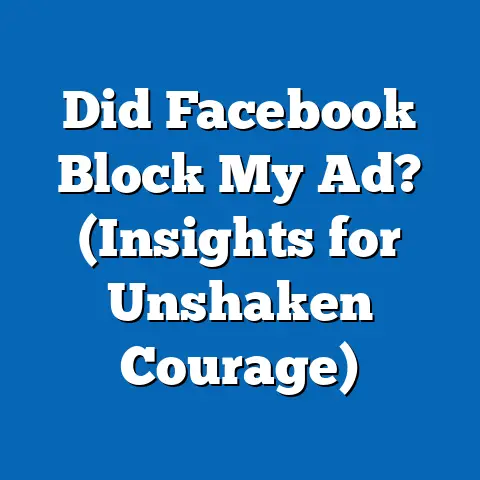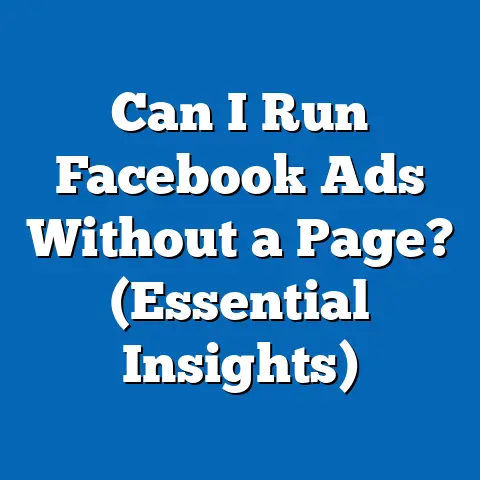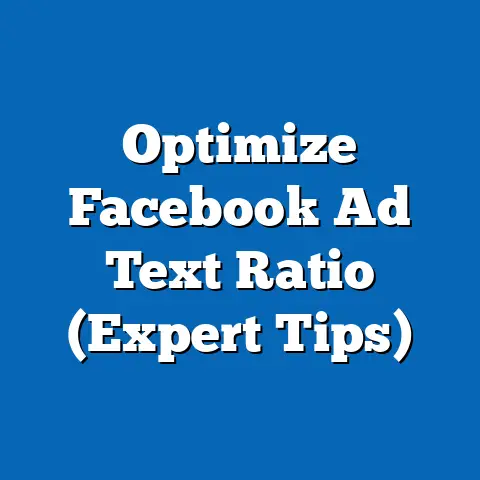Boost ROI with Facebook & Instagram Ads (Pro Strategies)
Have you ever wondered why some businesses see skyrocketing returns from their social media ads while others struggle to break even? In today’s digital landscape, Facebook and Instagram advertising remains a powerhouse for businesses aiming to maximize their return on investment (ROI), with global ad spending on these platforms projected to reach $219 billion by 2024, according to eMarketer. This article dives deep into professional strategies to boost ROI, backed by data-driven insights, demographic trends, and historical comparisons, to help marketers and business owners unlock the full potential of these platforms.
Recent data from Statista reveals that Facebook and Instagram, under Meta’s umbrella, boast a combined user base of over 3.5 billion monthly active users as of 2023, making them indispensable for targeted advertising. Studies by Hootsuite show that businesses can achieve an average ROI of $5.78 for every dollar spent on Facebook ads when campaigns are optimized effectively. However, without the right strategies, many advertisers fail to capitalize on this potential, often wasting budgets on poorly targeted or unengaging campaigns.
Section 1: The Current Landscape of Facebook & Instagram Advertising
Unpacking the Numbers: Ad Spend and ROI Trends
The scale of advertising on Facebook and Instagram is staggering. According to eMarketer, global ad revenue for Meta platforms reached $114.9 billion in 2022, with a projected annual growth rate of 8.4% through 2027. This growth reflects the platforms’ dominance in digital marketing, driven by their unparalleled ability to target specific audiences using granular data.
A 2023 report by Social Media Examiner found that 78% of marketers consider Facebook ads effective for driving sales, while Instagram ads are particularly potent for brand awareness, with 83% of users discovering new products through the platform. However, the average cost-per-click (CPC) on Facebook has risen to $0.97 in 2023, up from $0.70 in 2019, indicating increased competition for ad space. Despite this, well-optimized campaigns can still yield impressive returns, with top-performing industries like e-commerce seeing conversion rates as high as 9.21%, per WordStream data.
Why ROI Matters More Than Ever
ROI isn’t just a buzzword—it’s the lifeblood of any ad campaign. With rising CPCs and an increasingly crowded digital space, businesses must prioritize strategies that maximize every dollar spent. The good news? Advanced targeting, creative optimization, and data analytics tools available on Meta platforms allow advertisers to refine campaigns like never before, ensuring higher returns when executed correctly.
Section 2: Demographic Breakdowns – Who’s Clicking and Converting?
Age and Gender Insights
Understanding your audience is the cornerstone of effective advertising, and Facebook and Instagram offer unparalleled demographic targeting options. According to Pew Research Center (2023), 68% of adults aged 18-29 use Instagram, compared to 47% of those aged 30-49, making it a prime platform for reaching younger audiences. Facebook, while still popular among younger users (70% of 18-29-year-olds), also captures a significant portion of older demographics, with 65% of adults aged 50-64 active on the platform.
Gender differences also play a role in engagement. Statista data indicates that women make up 54% of Instagram’s user base and are more likely to engage with lifestyle and beauty content, while men (46%) show higher interaction rates with tech and gaming ads. On Facebook, the gender split is more balanced (51% women, 49% men), but women tend to have higher click-through rates (CTR) at 0.9% compared to men’s 0.7%, per AdEspresso research.
Geographic and Income-Based Targeting
Geographic targeting reveals significant opportunities as well. In the U.S., urban users account for 60% of Instagram’s engagement, while suburban and rural users dominate Facebook’s user base at 55% combined, according to Hootsuite. Income levels also influence ad performance—users with household incomes above $75,000 are 20% more likely to convert on high-ticket items through Facebook ads, per Meta’s internal data.
These demographic insights underscore the importance of tailoring campaigns to specific audience segments. For instance, a luxury brand might focus on Instagram ads targeting urban women aged 25-34 with above-average incomes, while a local service provider could leverage Facebook to reach suburban families across broader age ranges.
Section 3: Historical Trends – How Ad Performance Has Evolved
Comparing Costs and Effectiveness Over Time
The cost of advertising on Facebook and Instagram has risen significantly over the past decade, reflecting both increased demand and platform algorithm changes. In 2015, the average CPC on Facebook was just $0.27, compared to $0.97 in 2023, a 259% increase, according to WordStream. Instagram, which began rolling out ads in 2013, saw its CPC climb from $0.70 in 2017 to $1.42 in 2023, driven by its visual-first appeal and high engagement rates.
However, the effectiveness of ads has also improved with technological advancements. In 2015, the average CTR for Facebook ads was 0.9%, while today it hovers around 1.33% for well-optimized campaigns, per AdEspresso. Instagram’s CTR has similarly risen from 0.6% in 2017 to 0.98% in 2023, reflecting better targeting capabilities and user-friendly ad formats like Stories and Reels.
Shifts in User Behavior and Platform Features
Historically, user behavior has shifted alongside platform updates. The introduction of Instagram Stories in 2016 and Reels in 2020 transformed how brands engage audiences, with Stories ads achieving 15-25% higher completion rates than traditional feed ads, per Meta’s 2022 insights. On Facebook, the rise of video content has driven a 20% increase in engagement since 2018, as users spend an average of 26 minutes daily watching videos on the platform, according to eMarketer.
These historical shifts highlight the need for advertisers to stay agile. What worked five years ago—static image ads with broad targeting—may not yield the same results today. Adapting to new formats and leveraging data analytics is no longer optional; it’s essential for staying competitive.
Section 4: Pro Strategies to Boost ROI on Facebook & Instagram Ads
Strategy 1: Hyper-Targeted Audience Segmentation
One of the most effective ways to boost ROI is through precise audience segmentation. Meta’s ad platform allows advertisers to target users based on interests, behaviors, demographics, and even life events (e.g., recent engagements or purchases). A 2023 study by Social Media Today found that campaigns using custom audiences see a 37% higher CTR compared to broadly targeted ads.
For example, instead of targeting “all women aged 18-34,” a cosmetics brand could target “women aged 18-34 who follow beauty influencers and have purchased skincare products online in the past 6 months.” This specificity reduces wasted ad spend and increases relevance, driving conversions. Utilize tools like Facebook’s Lookalike Audiences to expand reach while maintaining precision—campaigns using this feature report a 30% lower cost-per-acquisition (CPA), per Meta data.
Strategy 2: Leverage High-Engagement Ad Formats
Ad format matters. Instagram Reels ads, for instance, have a 22% higher engagement rate than standard image ads, according to Hootsuite’s 2023 report. Similarly, Facebook video ads achieve a 6% higher conversion rate than static ads, per WordStream.
To capitalize on this, create short, visually compelling content that aligns with platform trends. Use Instagram Stories for limited-time offers (e.g., “24-hour flash sale!”) to create urgency, and test carousel ads on Facebook to showcase multiple products in a single placement. A/B testing different formats is crucial—Meta’s internal data shows that advertisers who test at least three ad variations see a 45% improvement in ROI.
Strategy 3: Optimize for Mobile-First Experiences
With 98.5% of Facebook users and 99.3% of Instagram users accessing these platforms via mobile devices (Statista, 2023), mobile optimization is non-negotiable. Ads with mobile-friendly designs—think vertical videos, fast-loading images, and clear call-to-action (CTA) buttons—see a 27% higher conversion rate, per Meta’s analytics.
Ensure landing pages are mobile-responsive as well. A 2022 Google study found that 53% of users abandon sites that take longer than 3 seconds to load on mobile. Streamline checkout processes and minimize form fields to reduce friction, boosting overall campaign performance.
Strategy 4: Utilize Retargeting and Dynamic Ads
Retargeting remains a goldmine for ROI. According to Criteo, retargeted ads have a 70% higher conversion rate than initial ads, as they remind users of products they’ve already shown interest in. Dynamic ads, which automatically display personalized content based on user behavior, take this a step further—e-commerce brands using dynamic ads report a 34% increase in sales, per Meta’s 2023 case studies.
Set up pixel tracking on your website to capture user actions (e.g., viewed products, abandoned carts) and create retargeting campaigns with tailored messaging. For instance, offer a discount code to users who left items in their cart. These strategies keep your brand top-of-mind and drive higher returns.
Strategy 5: Monitor and Optimize with Data Analytics
Data is your best friend in ad optimization. Regularly analyze metrics like CTR, CPA, and return on ad spend (ROAS) using Meta’s Ads Manager. A 2023 HubSpot report found that marketers who review campaign data weekly achieve a 20% higher ROI compared to those who don’t.
Use insights to refine underperforming ads—pause creatives with low engagement, reallocate budget to top performers, and test new audiences. Additionally, leverage Meta’s machine learning tools like Automated App Ads, which optimize delivery for conversions. Campaigns using automated bidding strategies see a 25% reduction in CPA, per Meta’s 2022 data.
Section 5: Future Projections – What Lies Ahead for Social Media Advertising?
Emerging Trends and Technologies
The future of Facebook and Instagram advertising looks promising, with innovations like augmented reality (AR) ads and artificial intelligence (AI)-driven targeting set to redefine the landscape. Meta’s 2023 investor report projects that AR ad formats, such as virtual try-ons for products, will account for 15% of ad revenue by 2027. AI tools will further enhance personalization, with predictive analytics expected to improve ad relevance by 30%, per eMarketer forecasts.
User behavior is also evolving. With Gen Z projected to make up 40% of global consumers by 2030 (Bloomberg), brands must adapt to their preference for authentic, value-driven content over traditional sales pitches. Instagram’s focus on Reels and short-form video will likely dominate, with video ad spend expected to grow by 12% annually through 2028, according to Statista.
Privacy and Regulation Challenges
However, challenges loom on the horizon. Stricter data privacy regulations, such as the EU’s General Data Protection Regulation (GDPR) and Apple’s App Tracking Transparency (ATT) framework, have already impacted targeting capabilities. Meta reported a $10 billion revenue loss in 2022 due to ATT changes, and eMarketer predicts that privacy constraints will reduce ad effectiveness by 5-10% over the next five years unless alternative solutions emerge.
Advertisers must pivot to first-party data strategies, such as building email lists and leveraging on-platform engagement metrics, to maintain targeting precision. Brands that adapt to these changes early will likely maintain a competitive edge.
Projected ROI Growth
Despite these hurdles, the outlook for ROI remains strong for savvy advertisers. eMarketer forecasts that global ad spend on Meta platforms will surpass $250 billion by 2027, with average ROAS expected to stabilize at $6-$7 per dollar spent for optimized campaigns. Businesses that invest in emerging formats, prioritize data ethics, and continuously test strategies will be best positioned to capitalize on this growth.
Conclusion: Turning Insights into Action
Maximizing ROI with Facebook and Instagram ads isn’t just about spending more—it’s about spending smarter. By leveraging hyper-targeted segmentation, high-engagement ad formats, mobile optimization, retargeting, and data analytics, businesses can transform their campaigns from cost centers into profit drivers. The data is clear: with the right strategies, an average ROI of $5.78 per dollar spent is within reach, and top performers can achieve even higher returns.
As we look to the future, staying ahead of trends like AR ads, AI targeting, and evolving privacy regulations will be critical. Historical data shows that adaptability is key—those who embraced video ads and Stories early reaped the rewards, and the same will hold true for tomorrow’s innovations. Start implementing these pro strategies today, monitor your metrics closely, and position your brand to thrive in the ever-changing world of social media advertising.





